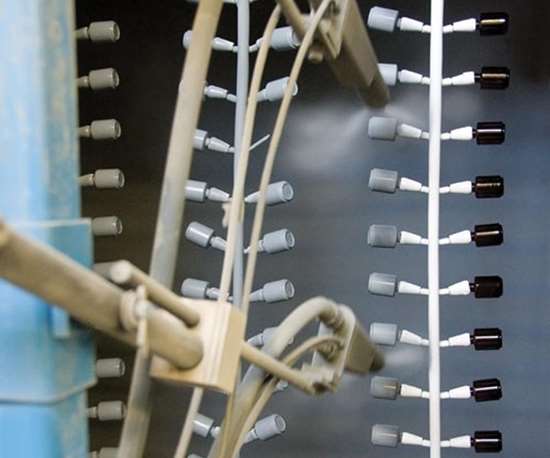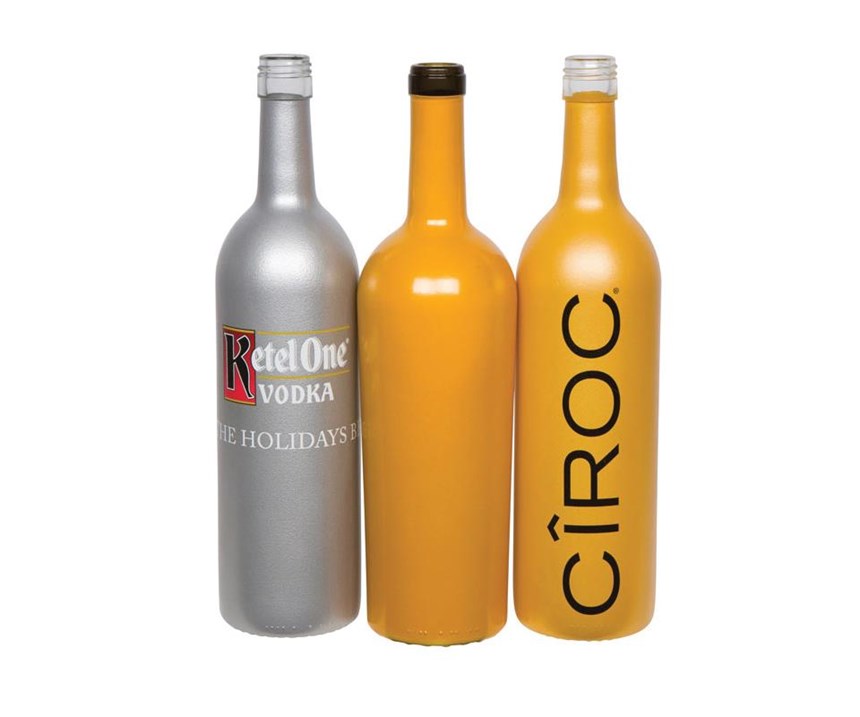Glass and Bottles Shine with Powder Coatings
Sundial Powder Coatings
becomes expert in nail polish and alcohol bottle coatings.
#curing
Who would have guessed that Shivie Dhillon knew so much about fingernail polish?
Judging from the thousands of bottles going through his shop each day, the president of Sundial Powder Coatings in Los Angeles has become an expert on the fashion trend.
Featured Content
Sundial Powder Coatings is a well-respected shop with a 30-year history. The company includes a seven-stage stainless steel deionized water pretreatment system and Six Sigma quality control methods. The company’s primary customers are for auto parts, car bodies and car cages, door frames and home appliances.
As an offshoot to his Sundial shop, Dhillon started a new division—Bottle Coatings Inc.—after being asked by several manufacturers to coat glass and cosmetic containers for their products to help with ultraviolet light protection. He started a website, bottlecoatings.com, to help garner more of that market segment.
“Light has an effect on the contents of some cosmetics, such as fingernail polish,” he says. “They needed UV protection so the polish wouldn’t begin curing inside the bottle. Powder coating is one solution to keep out UV.”
The demand was straightforward: UV light is not a friend of fingernail polish. If the product sitting on store shelves wasn’t protected from UV light, it would start to cure before being sold. The same could be said about alcohol and spirit bottles that Sundial is coating now; the UV light harms the liquid and causes it to lose its original taste and smell.
UV Protection
Dhillon says that blocking UV wavelengths is the only way a merchandiser can protect their product. Two methods they used in the past were absorption or converting the UV light, but he says both of those methods only work for a limited time.
“The longer the UV inhibitor is exposed to the UV wavelengths, the less effective it becomes, which shortens the shelf life of the product,” Dhillon says. “Filtering of UV wavelengths is just plain bad. With today’s high-end displays and artificial light, there is a multitude of UV light that is just not being filtered.”
It’s one thing to understand that UV nail gel cures prematurely inside the bottle from light penetration, but it’s another to be able to powder coat a glass bottle effectively to the exacting standards of the cosmetics manufacturers.
After all, looks are everything, and Dhillon’s staff worked hard to create a proprietary adhesive bond that works between the glass and the powder coating.
“That was no small feat, considering there is no natural electrostatic attraction there,” he says of the glass bottle.
Sundial developed a patented two-coat process that eliminates all UV light bands—UVA/UVB and UVC wavelengths—from penetrating the coating and damaging the product inside.
UVA rays are the ones that cause long-term skin damage. UVB rays are often referred to as “burning” rays because they cause sunburn. UVC rays are the strongest and most deadly of solar rays, but the ozone layer stops most of these.
Proper Weight Balance
What Sundial came up with ensures the exact amount of powder coating coverage to keep out UV, but without streaking or uneven distribution that could cause the small bottles to be out of balance with too much coating on one side of the container.
There was also another issue Dhillon and his team had to combat: The powder coating had to resist the often harsh ingredients in nail polish, essentially a lacquer that usually includes chemicals such as phthalates, toluene and formaldehyde, all of which can cause havoc on a coating.
Then comes the usual request of cosmetic manufacturers to match each bottle with the color of the nail polish. That also sent the Sundial team to the drawing board to generate a precise color-matching process, which is a very important requirement from the manufacturers.
“It gives the impression of the actual polish appearing through a transparent container, making it easy for consumers to know the color they are choosing,” Dhillon says.
Growing Market
Nail polish is a booming market in the cosmetic sector. More than $8.5 billion was spent on nail services in 2015, up from $8.2 billion in 2013, according to industry researchers. There were almost 130,000 nail salons in the U.S. in 2015, which doesn’t take into account consumers who do their nails themselves.
Sundial has also exploded into the fragrance and bottled spirits sector, which includes wine and liquors that also need to be protected from UV rays. Manufacturers are looking at moving products from ceramics to glass to get a better coating.
“Glass is more consistent than ceramic, which has always had a problem with cap closure and sealing,” Dhillon says. “The glass is much more predictable and allows us to create almost any design and color imaginable.”
Importance of Design
Packaging is something most manufacturers have not paid much attention to, but they are now. Affinnova, a global marketing technology company that has since been acquired by Nielsen, released its first Package Design Audit in 2013 to highlight the importance of package design, specifically in the liquor industry. The study showed that newer liquor brands Belvedere and Pinnacle were using more bold and unique package designs to gain market share, while at the same time attracting more consumer attention than established brands Smirnoff and Stolichnaya.
“Design remains one of the most underleveraged assets a company has in launching and maintaining a successful brand,” said Affinnova President Waleed Al-Atraqchi. “As advertising becomes increasingly fragmented, packaging must work harder to build brand equity and drive purchases.”
Al-Atraqchi believes that manufacturers are starting to monitor how package design is impacting shelf presence and consumer perception, similar to how they actively measure and adjust other aspects of their marketing performance.
Dhillon says manufacturers are starting to warm up more to powder coatings for the bottles. He has been meeting with numerous manufacturers and touting the benefits of powder coatings:
- A greater shelf life than liquid coatings
- Preserves the original diameter of the bottle neck threads
- An eco-friendly solution
- Can be treated with silver ionic technology that inhibits growth of microbes
- Available in a full range of colors, textures and glosses
Sundial also provides pad printing, silk screening and labeling services so that manufacturers can add their logos directly onto the bottle over the powder coatings.
Dhillon expects to grow his company’s market share because of its experience and know-how.
“Others have tried to devise a similarly workable solution, but the process requires specialized equipment, as well as significant knowledge gained from extensive research.”
For more information, visit sundialpowdercoating.com or bottlecoatings.com.
Originally published in the March 2017 issue.
RELATED CONTENT
-
Masking for Surface Finishing
Masking is employed in most any metal finishing operation where only a specifically defined area of the surface of a part must be exposed to a process. Conversely, masking may be employed on a surface where treatment is either not required or must be avoided. This article covers the many aspects of masking for metal finishing, including applications, methods and the various types of masking employed.
-
Anodizing Vs. Powder Coat
I am an engineer on a large yacht build project and urgently need information and advice on choosing a finish for the aluminum deck plates in the engine room.
-
Touch-up Options for Powder Coated Parts
Is it true that powder coating cannot be touched up? Powder coating expert Rodger Talbert offers options for powder coating touch-ups.






















